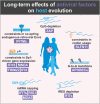Evolutionary conflicts and adverse effects of antiviral factors
- PMID: 33450175
- PMCID: PMC7811402
- DOI: 10.7554/eLife.65243
Evolutionary conflicts and adverse effects of antiviral factors
Abstract
Human cells are equipped with a plethora of antiviral proteins protecting them against invading viral pathogens. In contrast to apoptotic or pyroptotic cell death, which serves as ultima ratio to combat viral infections, these cell-intrinsic restriction factors may prevent or at least slow down viral spread while allowing the host cell to survive. Nevertheless, their antiviral activity may also have detrimental effects on the host. While the molecular mechanisms underlying the antiviral activity of restriction factors are frequently well investigated, potential undesired effects of their antiviral functions on the host cell are hardly explored. With a focus on antiretroviral proteins, we summarize in this review how individual restriction factors may exert adverse effects as trade-off for efficient defense against attacking pathogens.
Keywords: adverse effects; evolutionary biology; innate immunitya; restriction factors; viral pathogens.
© 2021, Sauter and Kirchhoff.
Conflict of interest statement
DS, FK No competing interests declared
Figures




Similar articles
-
Interferons and beyond: Induction of antiretroviral restriction factors.J Leukoc Biol. 2018 Mar;103(3):465-477. doi: 10.1002/JLB.3MR0717-307R. Epub 2017 Dec 15. J Leukoc Biol. 2018. PMID: 29345347 Review.
-
Autophagy and antiviral defense.IUBMB Life. 2022 Apr;74(4):317-338. doi: 10.1002/iub.2582. Epub 2021 Dec 3. IUBMB Life. 2022. PMID: 34859938 Review.
-
When good turns bad: how viruses exploit innate immunity factors.Curr Opin Virol. 2022 Feb;52:60-67. doi: 10.1016/j.coviro.2021.11.009. Epub 2021 Dec 3. Curr Opin Virol. 2022. PMID: 34872031 Review.
-
Immune Ecosystem of Virus-Infected Host Tissues.Int J Mol Sci. 2018 May 6;19(5):1379. doi: 10.3390/ijms19051379. Int J Mol Sci. 2018. PMID: 29734779 Free PMC article. Review.
-
HIV Exploits Antiviral Host Innate GCN2-ATF4 Signaling for Establishing Viral Replication Early in Infection.mBio. 2017 May 2;8(3):e01518-16. doi: 10.1128/mBio.01518-16. mBio. 2017. PMID: 28465428 Free PMC article.
Cited by
-
The RNA helicase DDX39A binds a conserved structure in chikungunya virus RNA to control infection.Mol Cell. 2023 Nov 16;83(22):4174-4189.e7. doi: 10.1016/j.molcel.2023.10.008. Epub 2023 Nov 9. Mol Cell. 2023. PMID: 37949067 Free PMC article.
-
Anatomical, subset, and HIV-dependent expression of viral sensors and restriction factors.Cell Rep. 2025 Jan 28;44(1):115202. doi: 10.1016/j.celrep.2024.115202. Epub 2025 Jan 10. Cell Rep. 2025. PMID: 39798087 Free PMC article.
-
Nrf2 activator PB125® as a carnosic acid-based therapeutic agent against respiratory viral diseases, including COVID-19.Free Radic Biol Med. 2021 Nov 1;175:56-64. doi: 10.1016/j.freeradbiomed.2021.05.033. Epub 2021 May 28. Free Radic Biol Med. 2021. PMID: 34058321 Free PMC article. Review.
-
Switching Sides: How Endogenous Retroviruses Protect Us from Viral Infections.J Virol. 2021 May 24;95(12):e02299-20. doi: 10.1128/JVI.02299-20. Print 2021 May 24. J Virol. 2021. PMID: 33883223 Free PMC article. Review.
-
The RLR intrinsic antiviral system is expressed in neural retina and restricts lentiviral transduction of human Mueller cells.Exp Eye Res. 2023 Nov;236:109647. doi: 10.1016/j.exer.2023.109647. Epub 2023 Sep 7. Exp Eye Res. 2023. PMID: 37689341 Free PMC article.
References
-
- Aerts L, Hamelin MÈ, Rhéaume C, Lavigne S, Couture C, Kim W, Susan-Resiga D, Prat A, Seidah NG, Vergnolle N, Riteau B, Boivin G. Modulation of protease activated receptor 1 influences human Metapneumovirus disease severity in a mouse model. PLOS ONE. 2013;8:e72529. doi: 10.1371/journal.pone.0072529. - DOI - PMC - PubMed
-
- Alexandrov LB, Nik-Zainal S, Wedge DC, Aparicio SA, Behjati S, Biankin AV, Bignell GR, Bolli N, Borg A, Børresen-Dale AL, Boyault S, Burkhardt B, Butler AP, Caldas C, Davies HR, Desmedt C, Eils R, Eyfjörd JE, Foekens JA, Greaves M, Hosoda F, Hutter B, Ilicic T, Imbeaud S, Imielinski M, Imielinsk M, Jäger N, Jones DT, Jones D, Knappskog S, Kool M, Lakhani SR, López-Otín C, Martin S, Munshi NC, Nakamura H, Northcott PA, Pajic M, Papaemmanuil E, Paradiso A, Pearson JV, Puente XS, Raine K, Ramakrishna M, Richardson AL, Richter J, Rosenstiel P, Schlesner M, Schumacher TN, Span PN, Teague JW, Totoki Y, Tutt AN, Valdés-Mas R, van Buuren MM, van 't Veer L, Vincent-Salomon A, Waddell N, Yates LR, Australian Pancreatic Cancer Genome Initiative. ICGC Breast Cancer Consortium. ICGC MMML-Seq Consortium. ICGC PedBrain. Zucman-Rossi J, Futreal PA, McDermott U, Lichter P, Meyerson M, Grimmond SM, Siebert R, Campo E, Shibata T, Pfister SM, Campbell PJ, Stratton MR. Signatures of mutational processes in human Cancer. Nature. 2013;500:415–421. doi: 10.1038/nature12477. - DOI - PMC - PubMed
Publication types
MeSH terms
Substances
LinkOut - more resources
Full Text Sources
Other Literature Sources
Medical

